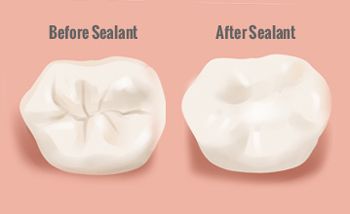
Benefits Of Dental Sealants That You Must Know.
A daily commitment is necessary to maintain good oral health and healthy teeth and gums. When going to the dentist for a routine checkup, it’s not fun to keep your fingers crossed and hope you don’t have cavities. Protect your teeth from decay-causing microorganisms with dental sealants. There are many tiny grooves on the biting surfaces of molars where bacteria can gather, causing decay and damage. Sealants are an effective tool for preventing damage to teeth. Here we discuss six benefits of dental sealants to use sealants on your teeth.
What are Dental Sealants?
Dental sealants are thin plastic covering that dentists paint onto the biting surfaces of their patients’ molars and premolars to prevent decay. Sealant clings quickly to the tooth’s surface, filling in ridges to prevent decay. Flossing and brushing are good ways to clean tooth enamel. Sealants prevent teeth from deterioration even if you brush regularly. They are commonly applied to the molars of children and teenagers once fully erupted.

Benefits of dental sealants
Dentists recommend that one should obtain sealants on their molar teeth as soon as they emerge. While children are the most common patients for sealants, adults with cavities can also benefit from the treatment. The significant benefits of dental sealants are as follows:
- Reduce Deep Grooves – Molars are more complex to clean due to deep ridges and depressions. No matter how well you brush, toothbrush bristles can’t reach teeth grooves and depressions. Back teeth with sealants prevent decay.
- Prevents cavities – The “tooth-colored” plastic in tooth sealants helps prevent cavities by sealing off the chewing surface of molars. As a result of this extra defense, bacteria have a much harder time adhering to a tooth’s surface and causing damage.
- Quick and painless procedure – Sealing is easy. A treatment like lemon juice/vinegar helps prepare teeth; it roughens the surface so the sealant can attach. Following tooth preparation, the dentist applies acrylic sealant. The tooth becomes sealed and protected from microorganisms in the pits and grooves after 1-2 minutes. For sealant, teeth are cleaned and dried.
- Suitable For All Ages – It’s a common misconception that sealants exclusively benefit kids. Though youngsters make up the bulk of patients, the treatment’s benefits are available to people of all ages. Minor grooves in the permanent teeth of elderly patients help to prevent the accumulation of bacteria in the tooth.
- Long-lasting – Properly maintained sealants could prevent teeth from decaying for many years. During routine visits, the dentist may recommend reapplying or repairing sealants. Good oral hygiene and avoiding complex, biting objects will help sealants last longer.
- Cost Efficient – Sealants are a fast, painless, and cost-effective way to safeguard children’s teeth. Dental sealants prevent expensive and painful cavities for a fraction of the expense. Most general dental policies cover sealants.
Application Process
Dental hygienists use a revolving brush and paste to clean the tooth’s enamel. Water helps to clean the tooth before it is dried. The dentist applies an acidic solution to the tooth’s chewing surface where the fissure is for a few seconds, and then the answer is rinsed away. The result is a finely rougher surface than the adjacent tooth enamel and has many tiny, microscopic regions. The dental sealant may better adhere to the tooth’s rough exterior and minute areas.
The tooth is dried thoroughly once more, and then the liquid tooth sealant is painted onto the tooth and allowed to be set. Sometimes a special light is used to harden the dental sealant, but primarily using a two-component sealant because it may set without light. Dental sealant cures into a hard plastic varnish layer, restoring chewing function to the tooth.
Final thoughts
Dental sealants provide a potent two-pronged defense against tooth decay, thwarting its development from its earliest stages up to a full-blown cavity when used with regular brushing and flossing. Experts agree that dental sealants can reduce the risk of cavities by 80% for two years and 50% for up to four years. However, remember that tooth sealants are not a replacement for regular fluoride toothpaste and flossing. If you or your child are considering getting sealants, it is in your best interest to consult with your dentist first.
Contact your kids’ dentist in Stockton, Sajjad Rizvi D.D.S. at Happy Kids Dental, today to learn more about the benefits of dental sealants.
Resource:
Do Sealants Prevent Tooth Decay?
This media/content or any other on this website does not prescribe, recommend, or prevent any treatment or procedure. Therefore, we highly recommend that you get the advice of a qualified dentist or other medical practitioners regarding your specific dental condition .
Subscribe To Our Newsletter
Get Updates And Learn From The Best


